
|
It brightened up to -4.9 mag due to the forward scattering on Oct. 9 in the SOHO coronagraph images (M. Paradowski). It became a great comet of 0 mag on the ground. Now it is 7.7 mag (Nov. 11, Osamu Miyazaki). Fading rapidly. It will be unobservable soon in the Southern Hemisphere, or in January in the Northern Hemisphere. But it will be observable again in January in the Northern Hemisphere, or in March in the Southern Hemisphere.
Date(TT) R.A. (2000) Decl. Delta r Elong. m1 Best Time(A, h)
Nov. 9 18 27.24 3 55.9 1.255 1.078 55 6.7 18:25 ( 66, 36)
Nov. 16 18 43.48 4 3.9 1.491 1.207 53 7.5 18:21 ( 68, 35)
|

|
Bright new Kreutz sungrazer comet. Large outburst occured on Oct. 18 and it brightened up to 8.2 mag (Oct. 20, Martin Masek). It approached to Sun down to 0.008 a.u. on Oct. 28. It was expected to brighten up to 2 mag, or -4.5 mag at best. However, it completely disappered at the perihelion. It is appearing in the morning sky, but probably nothing remains.
Date(TT) R.A. (2000) Decl. Delta r Elong. m1 Best Time(A, h)
Nov. 9 12 41.58 -22 19.6 0.995 0.553 32 9.9 5:02 (301, 5)
Nov. 16 12 10.32 -27 13.2 0.981 0.761 45 11.0 5:08 (315, 11)
|

|
It is expected to brighten very rapidly up to 10 mag from November to Decemebr. Now it is 12.9 mag (Nov. 12, Mike Olason). It brightens up to 9.5 mag, but it will turn to fade out rapidly after that. It will be fainter than 18 mag in March. In the Northern Hemisphere, it stays observable in good condition. In the Southern Hemisphere, it will be unobservable in December.
Date(TT) R.A. (2000) Decl. Delta r Elong. m1 Best Time(A, h)
Nov. 9 11 3.64 9 11.1 1.177 1.148 63 11.7 5:02 (294, 44)
Nov. 16 11 17.12 15 13.6 0.980 1.128 69 11.0 5:08 (292, 51)
|

|
It returned for the first time in 68 years. It brightened up to 6.2 mag in early summer (July 1, Virgilio Gonano). Now it is 10.1 mag (Nov. 10, Mike Olason). It will fade out rapidly after this. Now it is not observable. It will appear in January.
Date(TT) R.A. (2000) Decl. Delta r Elong. m1 Best Time(A, h)
Nov. 9 16 0.66 -7 7.0 3.120 2.202 18 11.6 18:25 ( 81, 0)
Nov. 16 16 13.42 -8 39.5 3.215 2.276 15 11.9 18:21 ( 81, -3)
|
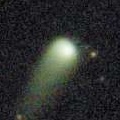
|
Now it is 12.9 mag (Nov. 11, Osamu Miyazaki). It stays 12 mag for a while. In the Northern Hemisphere, it stays observable in good condition. In the Southern Hemisphere, it is not observable now.
Date(TT) R.A. (2000) Decl. Delta r Elong. m1 Best Time(A, h)
Nov. 9 6 35.89 63 33.4 3.100 3.700 120 11.8 3:25 (180, 62)
Nov. 16 6 8.65 65 40.7 3.041 3.709 126 11.7 2:31 (180, 59)
|

|
It returns for the first time in 70 years. It brightened up to 3.7 mag in early April (Apr. 6, Jose Guilherme Aguiar). Now it is 14.6 mag (Oct. 22, Hidetaka Sato). Fading slowly. In the Northern Hemisphere, it is not observable now, but it will appear in February. It locates somewhat low in the Southern Hemisphere. But it will become high in winter.
Date(TT) R.A. (2000) Decl. Delta r Elong. m1 Best Time(A, h)
Nov. 9 15 9.73 -47 34.7 3.901 3.092 30 12.8 18:25 ( 50,-30)
Nov. 16 15 22.46 -47 37.4 4.000 3.171 28 13.0 5:08 (310,-30)
|

|
It approaches to Sun down to 0.09 a.u. on Jan. 13. According to the calculation, it will brighten up to -1 mag. But probably, it will be disintegrated. At the high light, it may be observable after the perihelion passage only in the Southern Hemisphere. Now it is 11.9 mag (Oct. 30, Chris Wyatt). It will brighten rapidly after this. In the Northern Hemisphere, it will never be observable after this. In the Southern Hemisphere, it will be unobservable in December.
Date(TT) R.A. (2000) Decl. Delta r Elong. m1 Best Time(A, h)
Nov. 9 15 7.33 -43 36.8 2.522 1.698 26 13.3 18:25 ( 55,-29)
Nov. 16 15 21.09 -42 49.1 2.418 1.569 24 12.9 5:08 (304,-28)
|

|
Now it is 13.4 mag (Oct. 31, Thomas Lehmann). It stays 14 mag for a while. It will be unobservable in January in the Northern Hemisphere, or in December in the Southern Hemisphere. But it will be observable again in February in the Northern Hemisphere.
Date(TT) R.A. (2000) Decl. Delta r Elong. m1 Best Time(A, h)
Nov. 9 18 36.60 -26 36.3 2.856 2.370 51 13.0 18:25 ( 41, 15)
Nov. 16 18 49.30 -24 41.5 2.923 2.369 47 13.1 18:21 ( 45, 15)
|

|
It became much brighter than expected. Now it is 13.1 mag (Nov. 1, Thomas Lehmann). It will fade out rapidly after this. It locates somewhat low in the Northern Hemisphere. But it will become high in winter. In the Southern Hemisphere, it is not observable now, but it will appear in February.
Date(TT) R.A. (2000) Decl. Delta r Elong. m1 Best Time(A, h)
Nov. 9 14 52.43 37 5.7 2.071 1.690 53 13.7 5:02 (234, 14)
Nov. 16 15 16.55 34 18.5 2.118 1.716 53 13.9 5:08 (238, 14)
|
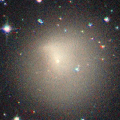
|
Major outburst occcured on Nov. 3. Now it is 11.1 mag (Nov. 6, Toshihiko Ikemura, Hirohisa Sato). In the Northern Hemisphere, it stays observable in good condition. In the Southern Hemisphere, it will be getting higher gradually.
Date(TT) R.A. (2000) Decl. Delta r Elong. m1 Best Time(A, h)
Nov. 9 10 6.94 10 5.1 6.398 6.243 76 14.0 5:02 (308, 54)
Nov. 16 10 9.07 9 47.2 6.286 6.244 83 14.0 5:08 (319, 59)
|

|
It is expected to brighten up to 13.5 mag, and it will be observable in good condition in winter. Now it is 14.9 mag (Nov. 6, Toshihiko Ikemura, Hirohisa Sato). Fading gradually. In the Northern Hemisphere, it stays observable in good condition. In the Southern Hemisphere, it will be getting lower gradually after this, and it will be unobservable in January.
Date(TT) R.A. (2000) Decl. Delta r Elong. m1 Best Time(A, h)
Nov. 9 6 31.12 -13 31.9 0.993 1.709 119 14.3 3:18 ( 0, 41)
Nov. 16 6 15.81 -8 48.8 0.892 1.704 129 14.1 2:36 ( 0, 46)
|

|
Now it is 13.8 mag (Oct. 31, ATLAS Chile). It will fade out rapidly after this. It will be unobservable in February in the Northern Hemisphere, or in December in the Southern Hemisphere.
Date(TT) R.A. (2000) Decl. Delta r Elong. m1 Best Time(A, h)
Nov. 9 18 21.67 -24 54.1 2.127 1.642 48 14.2 18:25 ( 45, 14)
Nov. 16 18 43.97 -24 7.5 2.177 1.656 46 14.4 18:21 ( 46, 15)
|

|
Now it is 14.1 mag (Aug. 29, Chris Wyatt). It stays 14 mag for a while. Now it is not observable. It will appear soon in the Northern Hemisphere, or in December in the Southern Hemisphere.
Date(TT) R.A. (2000) Decl. Delta r Elong. m1 Best Time(A, h)
Nov. 9 14 10.55 -19 13.5 5.972 5.004 11 14.4 5:02 (287,-10)
Nov. 16 14 17.75 -19 16.5 5.953 5.010 16 14.4 5:08 (290, -5)
|
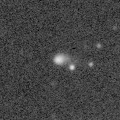
|
Now it is 14.3 mag (Oct. 27, W. Pei). It stays 14 mag for a while. It stays observable in good condition.
Date(TT) R.A. (2000) Decl. Delta r Elong. m1 Best Time(A, h)
Nov. 9 6 46.65 2 57.5 5.332 5.917 122 14.4 3:34 ( 0, 58)
Nov. 16 6 45.86 3 2.4 5.230 5.898 128 14.4 3:05 ( 0, 58)
|

|
It is expected to brighten up to 13 mag in 2025 autumn, and it will be observable in good condition. Now it is 14.6 mag (Nov. 3, Hiroshi Abe). It stays 15 mag for a while. In the Northern Hemisphere, it stays observable in good condition. In the Southern Hemisphere, it will be getting lower gradually after this, and it will be unobservable in February.
Date(TT) R.A. (2000) Decl. Delta r Elong. m1 Best Time(A, h)
Nov. 9 22 36.61 -5 22.0 3.998 4.464 111 14.5 19:21 ( 0, 50)
Nov. 16 22 38.14 -5 12.1 4.068 4.433 105 14.5 18:55 ( 0, 50)
|

|
First return of a new periodic comet which brightened up to 16 mag in 2012. Now it is 14.8 mag (Nov. 2, Toshihiko Ikemura, Hirohisa Sato). It will fade out rapidly after this. It will be fainter than 18 mag in February. In the Northern Hemisphere, it stays observable in good condition. In the Southern Hemisphere, it will be unobservable in December.
Date(TT) R.A. (2000) Decl. Delta r Elong. m1 Best Time(A, h)
Nov. 9 4 24.12 36 0.3 0.888 1.826 152 14.5 1:12 (180, 89)
Nov. 16 4 10.62 40 28.0 0.886 1.835 156 14.5 0:32 (180, 85)
|

|
It brightened up to 9.6 mag from February to March (Feb. 25, Thomas Lehmann). Now it is 14.7 mag (Nov. 3, Thomas Lehmann). Fading slowly. In the Northern Hemisphere, it stays observable in good condition. In the Southern Hemisphere, it will be unobservable soon.
Date(TT) R.A. (2000) Decl. Delta r Elong. m1 Best Time(A, h)
Nov. 9 20 14.12 37 14.4 3.535 3.703 91 14.7 18:25 (104, 73)
Nov. 16 20 22.48 36 1.5 3.661 3.774 88 14.9 18:21 (100, 69)
|
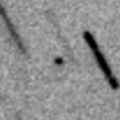
|
It will fade out rapidly after this. It will be fainter than 18 mag in February. In the Northern Hemisphere, it will be unobservable in December. But it will be observable again in January. In the Southern Hemisphere, it will never be observable after this.
Date(TT) R.A. (2000) Decl. Delta r Elong. m1 Best Time(A, h)
Nov. 9 16 10.67 -2 47.3 2.609 1.739 22 15.0 18:25 ( 83, 5)
Nov. 16 16 29.53 -2 56.6 2.706 1.829 22 15.3 18:21 ( 84, 4)
|

|
Now it is 16.7 mag (Nov. 3, Hiroshi Abe). It stays 15 mag for a while. In the Northern Hemisphere, it stays observable in good condition. In the Southern Hemisphere, it is not observable now.
Date(TT) R.A. (2000) Decl. Delta r Elong. m1 Best Time(A, h)
Nov. 9 7 53.76 69 1.6 2.056 2.587 111 15.2 4:41 (180, 56)
Nov. 16 8 9.03 70 21.4 2.015 2.581 113 15.1 4:29 (180, 55)
|
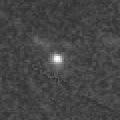
|
Now it is 15.8 mag (Nov. 4, Thomas Lehmann). Brightening slowly. In the Northern Hemisphere, it stays observable in good condition.
Date(TT) R.A. (2000) Decl. Delta r Elong. m1 Best Time(A, h)
Nov. 9 9 0.86 21 55.8 2.417 2.696 95 15.5 5:02 (320, 73)
Nov. 16 9 6.80 21 24.3 2.318 2.687 100 15.4 5:08 (342, 76)
|
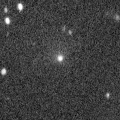
|
Very large comet. It is expected to brighten up to 13 mag in 2031. Now it is 15.2 mag (Sept. 26, Martin Masek). It stays 15 mag for a while. In the Northern Hemisphere, it is not observable now. In the Southern Hemisphere, it stays observable in good condition. In the Northern Hemisphere, it is not observable until 2030.
Date(TT) R.A. (2000) Decl. Delta r Elong. m1 Best Time(A, h)
Nov. 9 4 5.99 -70 28.1 15.704 15.768 91 15.5 0:52 ( 0,-15)
Nov. 16 4 2.14 -70 38.6 15.706 15.744 90 15.5 0:21 ( 0,-16)
|
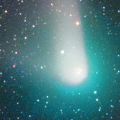
|
It brightened up to 8 mag from 2022 summer to 2023 spring. Now it is 15.6 mag (Nov. 6, ATLAS-MLO, Mauna Loa). It stays 16 mag for a while. It stays observable in good condition.
Date(TT) R.A. (2000) Decl. Delta r Elong. m1 Best Time(A, h)
Nov. 9 6 16.29 19 19.4 6.515 7.224 132 15.5 3:04 ( 0, 74)
Nov. 16 6 12.81 19 34.5 6.487 7.279 140 15.5 2:33 ( 0, 75)
|

|
Now it is 15.6 mag (Nov. 4, ATLAS-MLO, Mauna Loa). It stays 16 mag for a while. It stays observable in good condition.
Date(TT) R.A. (2000) Decl. Delta r Elong. m1 Best Time(A, h)
Nov. 9 6 42.08 11 15.8 2.819 3.487 125 15.7 3:29 ( 0, 66)
Nov. 16 6 41.60 10 48.9 2.757 3.498 132 15.6 3:01 ( 0, 66)
|

|
It was observed at 9-10 mag for a long time in 2023. Now it is 15.4 mag (Nov. 7, ATLAS South Africa). It stays 16 mag for a while. In the Northern Hemisphere, it will never be observable after this. In the Southern Hemisphere, it will be getting lower gradually. But it will be getting higher again after February.
Date(TT) R.A. (2000) Decl. Delta r Elong. m1 Best Time(A, h)
Nov. 9 20 53.78 -66 14.4 6.147 5.955 74 15.7 18:25 ( 5,-11)
Nov. 16 20 52.80 -65 29.3 6.283 6.010 69 15.8 18:21 ( 7,-11)
|

|
Now it is 16.1 mag (Nov. 1, Thomas Lehmann). It stays 16 mag for a while. It stays extremely low in the Northern Hemisphere. But it will become high in autumn. In the Southern Hemisphere, it stays observable in good condition.
Date(TT) R.A. (2000) Decl. Delta r Elong. m1 Best Time(A, h)
Nov. 9 9 41.51 -36 23.9 3.842 3.648 71 15.7 5:02 (342, 16)
Nov. 16 9 35.27 -37 45.7 3.791 3.693 76 15.7 5:08 (350, 16)
|

|
Now it is 16.6 mag (Oct. 31, ATLAS Chile). It stays 16 mag for a while. It locates somewhat low in the Northern Hemisphere. But it will become high in winter. In the Southern Hemisphere, it stays observable in good condition.
Date(TT) R.A. (2000) Decl. Delta r Elong. m1 Best Time(A, h)
Nov. 9 8 15.26 -26 54.7 4.167 4.306 91 15.9 5:02 ( 0, 28)
Nov. 16 8 13.10 -26 56.0 4.050 4.281 96 15.9 4:32 ( 0, 28)
|
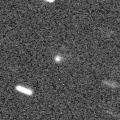
|
Now it is 16.5 mag (Nov. 2, Martin Masek). It stays 16 mag for a while. In the Northern Hemisphere, it will be getting higher gradually. In the Southern Hemisphere, it is not observable now, but it will be observable soon.
Date(TT) R.A. (2000) Decl. Delta r Elong. m1 Best Time(A, h)
Nov. 9 12 27.45 2 1.6 2.594 1.965 41 15.9 5:02 (285, 23)
Nov. 16 12 42.19 0 47.0 2.568 1.989 44 15.9 5:08 (289, 26)
|

|
It will be observable at 15 mag for a long time in 2025 in the Northern Hemisphere. Now it is 16.5 mag (Oct. 30, Ken-ichi Kadota). Brightening slowly. In the Northern Hemisphere, it stays observable in good condition. In the Southern Hemisphere, it is not observable now, but it will appear in December.
Date(TT) R.A. (2000) Decl. Delta r Elong. m1 Best Time(A, h)
Nov. 9 11 53.35 26 38.9 5.098 4.720 62 16.1 5:02 (265, 43)
Nov. 16 11 58.49 27 35.7 4.973 4.697 68 16.1 5:08 (267, 49)
|
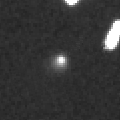
|
Now it is 16.5 mag (Nov. 8, ATLAS Chile). It stays 16 mag for a while. It locates somewhat low in the Northern Hemisphere. But it will become high in autumn. In the Southern Hemisphere, it stays observable in good condition.
Date(TT) R.A. (2000) Decl. Delta r Elong. m1 Best Time(A, h)
Nov. 9 7 10.33 -29 45.1 6.553 6.848 103 16.1 3:57 ( 0, 25)
Nov. 16 7 9.78 -30 6.5 6.476 6.835 107 16.1 3:29 ( 0, 25)
|

|
Now it is 15.3 mag (Nov. 6, Toshihiko Ikemura, Hirohisa Sato). It will fade out rapidly after this. It will be fainter than 18 mag in January. It stays observable in good condition.
Date(TT) R.A. (2000) Decl. Delta r Elong. m1 Best Time(A, h)
Nov. 9 2 1.70 6 34.7 1.512 2.476 163 16.3 22:45 ( 0, 62)
Nov. 16 1 56.76 6 34.1 1.577 2.510 155 16.5 22:13 ( 0, 62)
|

|
Now it is 17.2 mag (Nov. 3, Thomas Lehmann). Fading slowly. It stays observable in good condition.
Date(TT) R.A. (2000) Decl. Delta r Elong. m1 Best Time(A, h)
Nov. 9 22 33.31 7 23.3 0.683 1.422 115 16.4 19:19 ( 0, 62)
Nov. 16 22 52.30 6 51.4 0.705 1.419 112 16.3 19:10 ( 0, 62)
|

|
Now it is 15.8 mag (Nov. 2, Toshihiko Ikemura, Hirohisa Sato). It stays 16 mag for a while. It stays observable in good condition.
Date(TT) R.A. (2000) Decl. Delta r Elong. m1 Best Time(A, h)
Nov. 9 1 54.35 18 17.1 2.099 3.066 164 16.4 22:38 ( 0, 73)
Nov. 16 1 50.06 17 30.9 2.103 3.040 157 16.4 22:06 ( 0, 73)
|

|
Now it is 16.8 mag (May 18, ATLAS South Africa). It stays 16 mag for a while. It locates somewhat low in the Northern Hemisphere. In the Southern Hemisphere, it will be getting higher gradually.
Date(TT) R.A. (2000) Decl. Delta r Elong. m1 Best Time(A, h)
Nov. 9 11 46.39 -22 28.7 4.248 3.618 45 16.4 5:02 (311, 14)
Nov. 16 11 55.48 -23 37.3 4.177 3.606 48 16.4 5:08 (316, 16)
|

|
It brightened up to 8.3 mag in 2021-2022 winter (Jan. 6, 2022, Toshiyuki Takahashi). Now it is 15.1 mag (Aug. 2, Thomas Lehmann). It stays 17 mag for a while. In the Northern Hemisphere, it will never be observable after this. In the Southern Hemisphere, it will be getting higher gradually.
Date(TT) R.A. (2000) Decl. Delta r Elong. m1 Best Time(A, h)
Nov. 9 12 17.13 -51 6.0 9.686 9.036 46 16.4 5:02 (326,-11)
Nov. 16 12 21.16 -51 43.5 9.701 9.080 48 16.4 5:08 (330, -8)
|

|
First return of a new periodic comet which brightened up to 15 mag in 2010. It is expected to brighten up to 15 mag from winter to spring, and it will be observable in excellent condition in the Northern Hemisphere. Now it is 17.4 mag (Nov. 6, Ken-ichi Kadota). Brightening slowly. It stays observable in good condition.
Date(TT) R.A. (2000) Decl. Delta r Elong. m1 Best Time(A, h)
Nov. 9 2 43.27 5 30.8 1.134 2.113 168 16.7 23:26 ( 0, 61)
Nov. 16 2 36.03 6 8.2 1.102 2.066 162 16.5 22:52 ( 0, 61)
|

|
Now it is 15.8 mag (Nov. 6, ATLAS Chile). It stays 17 mag for a while. It stays extremely low in the Northern Hemisphere. In the Southern Hemisphere, it stays observable in good condition.
Date(TT) R.A. (2000) Decl. Delta r Elong. m1 Best Time(A, h)
Nov. 9 7 36.38 -47 19.6 6.104 6.194 90 16.6 4:23 ( 0, 8)
Nov. 16 7 29.93 -48 18.8 6.096 6.238 93 16.7 3:49 ( 0, 7)
|

|
Parent asteroid of Geminids meteor shower. Now it is 18.5 mag (Sept. 12, ATLAS-HKO, Haleakala). It stays 16 mag for a while. In the Northern Hemisphere, it stays observable in good condition. It locates somewhat low in the Southern Hemisphere.
Date(TT) R.A. (2000) Decl. Delta r Elong. m1 Best Time(A, h)
Nov. 9 4 42.01 39 36.2 1.131 2.039 147 16.9 1:31 (180, 85)
Nov. 16 4 20.96 39 20.2 1.048 1.993 156 16.6 0:42 (180, 86)
|

|
It brightened up to 16.9 mag before the perihelion passsage (Feb. 7, Toshihiko Ikemura, Hirohisa Sato). After the perihelion passage, it became fainter than this ephemeris. Now it is 18.4 mag (Nov. 6, Toshihiko Ikemura, Hirohisa Sato). It stays 17 mag for a while. It stays observable in good condition.
Date(TT) R.A. (2000) Decl. Delta r Elong. m1 Best Time(A, h)
Nov. 9 8 11.09 6 33.2 4.578 4.894 102 16.6 4:58 ( 0, 61)
Nov. 16 8 11.73 5 41.3 4.487 4.904 109 16.6 4:31 ( 0, 61)
|

|
It stays 17 mag for a while. In the Northern Hemisphere, it will be getting higher gradually. In the Southern Hemisphere, it is not observable now, but it will appear in December.
Date(TT) R.A. (2000) Decl. Delta r Elong. m1 Best Time(A, h)
Nov. 9 12 56.36 0 46.3 3.421 2.665 34 16.6 5:02 (281, 16)
Nov. 16 13 6.65 -0 19.4 3.400 2.701 38 16.7 5:08 (286, 20)
|
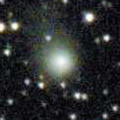
|
It brightened up to 12.1 mag in 2023 spring (May 20, 2023, Jose Guilherme de S. Aguiar). Now it is 17.1 mag (Oct. 31, ATLAS South Africa). It stays 17 mag for a while. It stays extremely low in the Northern Hemisphere. In the Southern Hemisphere, it stays observable in good condition.
Date(TT) R.A. (2000) Decl. Delta r Elong. m1 Best Time(A, h)
Nov. 9 6 48.32 -41 10.3 5.592 5.864 101 16.7 3:35 ( 0, 14)
Nov. 16 6 43.56 -41 25.9 5.589 5.913 104 16.7 3:03 ( 0, 14)
|

|
Now it is 17.0 mag (Nov. 6, ATLAS-MLO, Mauna Loa). It stays 17 mag for a while. It will be unobservable in February in the Northern Hemisphere, or in December in the Southern Hemisphere. But it will be observable again in March in the Northern Hemisphere.
Date(TT) R.A. (2000) Decl. Delta r Elong. m1 Best Time(A, h)
Nov. 9 22 23.44 23 51.5 5.243 5.747 116 16.7 19:08 ( 0, 79)
Nov. 16 22 19.46 22 51.6 5.302 5.704 109 16.7 18:36 ( 0, 78)
|

|
It brightened up to 12.0 mag in June (June 13, Ken-ichi Kadota). Now it is 17.3 mag (Oct. 31, Hirohisa Sato). Fading slowly. It will be fainter than 18 mag in February. In the Northern Hemisphere, it stays observable in good condition. It locates somewhat low in the Southern Hemisphere.
Date(TT) R.A. (2000) Decl. Delta r Elong. m1 Best Time(A, h)
Nov. 9 9 33.10 32 6.1 1.967 2.226 91 16.8 5:02 (275, 73)
Nov. 16 9 38.89 31 55.1 1.931 2.275 97 16.8 5:08 (283, 79)
|
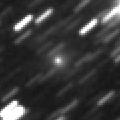
|
Very far object. Now it is 16.8 mag (Nov. 6, ATLAS Chile). It stays 17 mag for a while. In the Northern Hemisphere, it is not observable now. In the Southern Hemisphere, it stays observable in good condition.
Date(TT) R.A. (2000) Decl. Delta r Elong. m1 Best Time(A, h)
Nov. 9 1 21.67 -68 40.2 10.396 10.491 92 16.8 22:05 ( 0,-14)
Nov. 16 1 14.00 -68 9.7 10.453 10.497 89 16.8 21:30 ( 0,-13)
|

|
Now it is 15.0 mag (Nov. 8, Ken-ichi Kadota). Brightening slowly. It locates somewhat low in the Northern Hemisphere. In the Southern Hemisphere, it is not observable now. It is brighter than this ephemeris recently.
Date(TT) R.A. (2000) Decl. Delta r Elong. m1 Best Time(A, h)
Nov. 9 16 23.29 36 50.9 2.811 2.426 57 17.1 18:25 (117, 28)
Nov. 16 16 42.90 36 22.5 2.742 2.372 58 16.9 18:21 (117, 27)
|

|
Now it is 16.8 mag (Nov. 2, Toshihiko Ikemura, Hirohisa Sato). Fading gradually. It will be fainter than 18 mag in December. It stays observable in good condition.
Date(TT) R.A. (2000) Decl. Delta r Elong. m1 Best Time(A, h)
Nov. 9 0 37.82 -3 53.3 1.172 2.032 139 17.0 21:22 ( 0, 51)
Nov. 16 0 39.05 -3 38.2 1.227 2.037 133 17.1 20:56 ( 0, 52)
|

|
Now it is 18.1 mag (Nov. 4, Toshihiko Ikemura, Hirohisa Sato). Fading slowly. It will be fainter than 18 mag in February. In the Northern Hemisphere, it stays observable in good condition. In the Southern Hemisphere, it will be getting lower gradually.
Date(TT) R.A. (2000) Decl. Delta r Elong. m1 Best Time(A, h)
Nov. 9 22 47.76 -5 53.7 1.441 2.058 114 17.1 19:33 ( 0, 49)
Nov. 16 22 54.01 -5 11.8 1.499 2.047 109 17.1 19:11 ( 0, 50)
|

|
Now it is 17.5 mag (Nov. 6, Toshihiko Ikemura, Hirohisa Sato). It stays 17 mag for a while. It stays observable in good condition.
Date(TT) R.A. (2000) Decl. Delta r Elong. m1 Best Time(A, h)
Nov. 9 4 12.28 -15 1.0 3.140 3.977 143 17.1 1:00 ( 0, 40)
Nov. 16 4 8.63 -15 43.8 3.133 3.975 143 17.1 0:29 ( 0, 39)
|

|
It brightened up to 14.4 mag in summer (Aug. 17, Hiroshi Abe). Now it is 16.8 mag (Nov. 3, Thomas Lehmann). It will fade out rapidly after this. It will be fainter than 18 mag in December. In the Northern Hemisphere, it stays observable in good condition. It stays extremely low in the Southern Hemisphere.
Date(TT) R.A. (2000) Decl. Delta r Elong. m1 Best Time(A, h)
Nov. 9 6 22.41 36 17.3 0.966 1.779 130 17.2 3:10 (180, 89)
Nov. 16 6 17.96 38 58.8 0.968 1.825 137 17.3 2:38 (180, 86)
|

|
It will brighten up to 14 mag in 2025 spring. Now it is 17.0 mag (Oct. 31, ATLAS Chile). Brightening gradually. It locates somewhat low in the Northern Hemisphere. In the Southern Hemisphere, it stays observable in good condition.
Date(TT) R.A. (2000) Decl. Delta r Elong. m1 Best Time(A, h)
Nov. 9 23 34.45 -30 9.1 1.547 2.130 112 17.3 20:19 ( 0, 25)
Nov. 16 23 34.86 -29 21.8 1.574 2.083 106 17.3 19:52 ( 0, 26)
|
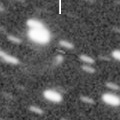
|
Now it is 17.4 mag (Nov. 7, ATLAS-HKO, Haleakala). It stays 18 mag for a while. In the Northern Hemisphere, it will be getting lower gradually. But it will be getting higher again after January. In the Southern Hemisphere, it will be unobservable soon. But it will be observable again in February.
Date(TT) R.A. (2000) Decl. Delta r Elong. m1 Best Time(A, h)
Nov. 9 19 5.88 21 30.5 4.820 4.611 71 17.3 18:25 ( 79, 54)
Nov. 16 19 7.11 20 10.0 4.935 4.635 66 17.4 18:21 ( 81, 48)
|

|
First return of a new periodic comet which brightened up to 15 mag in 2010. Now it is 18.7 mag (Nov. 4, Toshihiko Ikemura, Hirohisa Sato). Fading slowly. It will be fainter than 18 mag in February. In the Northern Hemisphere, it stays observable in good condition. It locates somewhat low in the Southern Hemisphere.
Date(TT) R.A. (2000) Decl. Delta r Elong. m1 Best Time(A, h)
Nov. 9 9 22.12 29 19.1 1.835 2.129 92 17.3 5:02 (288, 75)
Nov. 16 9 30.30 29 13.6 1.796 2.168 98 17.3 5:08 (301, 79)
|

|
Peculiar asteroid moving along a cometary orbit. It stays 17 mag for a while. It stays observable in good condition.
Date(TT) R.A. (2000) Decl. Delta r Elong. m1 Best Time(A, h)
Nov. 9 3 53.90 -10 33.5 1.996 2.892 149 17.5 0:42 ( 0, 45)
Nov. 16 3 49.05 -11 57.5 1.950 2.842 148 17.4 0:09 ( 0, 43)
|
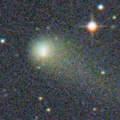
|
It brightened up to 11.1 mag in early 2022 (Mar. 31, 2022, F. Kugel, J.-G. Bosch, J. Nicolas). Now it is 16.9 mag (Oct. 20, ATLAS-MLO, Mauna Loa). It stays 18 mag for a while. In the Northern Hemisphere, it will be getting lower gradually. But it will be getting higher again after December. In the Southern Hemisphere, it will never be observable after this.
Date(TT) R.A. (2000) Decl. Delta r Elong. m1 Best Time(A, h)
Nov. 9 17 40.88 24 38.5 8.523 8.035 57 17.4 18:25 ( 96, 38)
Nov. 16 17 45.11 24 23.3 8.604 8.076 54 17.5 18:21 ( 98, 34)
|
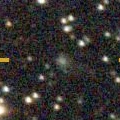
|
Now it is 17.8 mag (Nov. 6, Toshihiko Ikemura, Hirohisa Sato). It stays 18 mag for a while. In the Northern Hemisphere, it stays observable in good condition. It stays extremely low in the Southern Hemisphere.
Date(TT) R.A. (2000) Decl. Delta r Elong. m1 Best Time(A, h)
Nov. 9 7 43.02 40 16.5 6.514 6.987 114 17.5 4:30 (180, 85)
Nov. 16 7 43.18 40 31.5 6.435 7.000 121 17.4 4:03 (180, 85)
|

|
Now it is 17.3 mag (Oct. 31, ATLAS Chile). It stays 18 mag for a while. It will be unobservable in January.
Date(TT) R.A. (2000) Decl. Delta r Elong. m1 Best Time(A, h)
Nov. 9 19 38.47 -22 10.5 3.612 3.333 65 17.5 18:25 ( 31, 26)
Nov. 16 19 46.83 -21 56.3 3.696 3.328 60 17.5 18:21 ( 35, 25)
|

|
Now it is 17.5 mag (Oct. 2, ATLAS Chile). It stays 17 mag for a while. It will be unobservable in December. But it will be observable again in January in the Southern Hemisphere, or in February in the Northern Hemisphere. It is expected to brighten up to 13 mag in 2026, and it will be observable in excellent condition in the Northern Hemisphere. In the Southern Hemisphere, it locates very low at the high light.
Date(TT) R.A. (2000) Decl. Delta r Elong. m1 Best Time(A, h)
Nov. 9 18 32.43 -33 39.9 7.781 7.197 50 17.5 18:25 ( 38, 9)
Nov. 16 18 35.55 -33 10.5 7.824 7.154 44 17.5 18:21 ( 42, 6)
|

|
Now it is 18.4 mag (Nov. 3, Purple Mountain Observatory, XuYi Station). It stays 18 mag for a while. In the Northern Hemisphere, it stays observable in good condition. It locates somewhat low in the Southern Hemisphere.
Date(TT) R.A. (2000) Decl. Delta r Elong. m1 Best Time(A, h)
Nov. 9 7 21.33 32 33.6 1.590 2.243 118 17.8 4:08 ( 0, 87)
Nov. 16 7 25.81 34 11.7 1.526 2.243 124 17.7 3:45 ( 0, 89)
|

|
Now it is 17.5 mag (Oct. 22, ATLAS-HKO, Haleakala). It will fade out rapidly after this. It will be fainter than 18 mag soon. In the Northern Hemisphere, it stays observable in good condition. It stays extremely low in the Southern Hemisphere.
Date(TT) R.A. (2000) Decl. Delta r Elong. m1 Best Time(A, h)
Nov. 9 1 57.89 38 36.0 1.461 2.395 154 17.7 22:41 (180, 86)
Nov. 16 1 49.81 38 51.3 1.496 2.410 151 17.8 22:06 (180, 86)
|

|
Now it is 18.1 mag (Nov. 6, Toshihiko Ikemura, Hirohisa Sato). Fading slowly. It will be fainter than 18 mag in December. It stays observable in good condition.
Date(TT) R.A. (2000) Decl. Delta r Elong. m1 Best Time(A, h)
Nov. 9 3 15.66 16 18.3 3.542 4.530 175 17.7 0:04 ( 0, 71)
Nov. 16 3 10.96 16 7.7 3.556 4.542 175 17.8 23:27 ( 0, 71)
|

|
Now it is 17.8 mag (Oct. 20, Ken-ichi Kadota). It stays 18 mag for a while. In the Northern Hemisphere, it stays observable in good condition. It locates somewhat low in the Southern Hemisphere.
Date(TT) R.A. (2000) Decl. Delta r Elong. m1 Best Time(A, h)
Nov. 9 9 53.92 31 53.7 2.310 2.471 87 17.7 5:02 (272, 69)
Nov. 16 10 0.82 31 41.6 2.258 2.506 92 17.8 5:08 (278, 75)
|
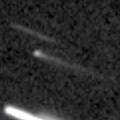
|
Now it is 16.6 mag (Nov. 8, Ken-ichi Kadota). Fading slowly. It will be fainter than 18 mag in December. It stays observable in good condition.
Date(TT) R.A. (2000) Decl. Delta r Elong. m1 Best Time(A, h)
Nov. 9 2 56.64 11 37.1 2.914 3.901 174 17.8 23:40 ( 0, 67)
Nov. 16 2 52.85 11 0.7 2.925 3.900 168 17.8 23:09 ( 0, 66)
|
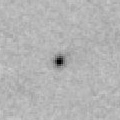
|
Now it is 17.4 mag (Nov. 4, ATLAS-MLO, Mauna Loa). It stays 18 mag for a while. It stays observable in good condition.
Date(TT) R.A. (2000) Decl. Delta r Elong. m1 Best Time(A, h)
Nov. 9 7 4.35 -2 23.7 4.082 4.604 116 18.0 3:51 ( 0, 53)
Nov. 16 7 3.35 -3 22.3 3.994 4.596 122 17.9 3:23 ( 0, 52)
|

|
Now it is 17.9 mag (May 17, J. L. Virlichie, P. Traverse, H. Roy). It stays 18 mag for a while. In the Northern Hemisphere, it is not observable now, but it will appear in December. In the Southern Hemisphere, it will be getting higher gradually.
Date(TT) R.A. (2000) Decl. Delta r Elong. m1 Best Time(A, h)
Nov. 9 12 47.53 -46 54.2 6.302 5.582 40 18.0 5:02 (320,-12)
Nov. 16 12 51.01 -46 60.0 6.259 5.568 42 17.9 5:08 (323, -8)
|

|
Now it is 17.4 mag (Oct. 1, Martin Masek). Fading slowly. In the Northern Hemisphere, it stays observable in good condition. It locates somewhat low in the Southern Hemisphere.
Date(TT) R.A. (2000) Decl. Delta r Elong. m1 Best Time(A, h)
Nov. 9 7 0.99 33 34.2 1.400 2.112 123 18.0 3:48 ( 0, 89)
Nov. 16 7 4.29 34 5.2 1.359 2.128 129 17.9 3:24 ( 0, 89)
|
|
![]()
 13P/Olbers
13P/Olbers C/2022 E2 ( ATLAS )
C/2022 E2 ( ATLAS ) 12P/Pons-Brooks
12P/Pons-Brooks C/2024 G3 ( ATLAS )
C/2024 G3 ( ATLAS ) C/2023 C2 ( ATLAS )
C/2023 C2 ( ATLAS ) C/2024 B1 ( Lemmon )
C/2024 B1 ( Lemmon ) 29P/Schwassmann-Wachmann 1
29P/Schwassmann-Wachmann 1 C/2024 M1 ( ATLAS )
C/2024 M1 ( ATLAS ) 37P/Forbes
37P/Forbes C/2021 G2 ( ATLAS )
C/2021 G2 ( ATLAS ) C/2022 QE78 ( ATLAS )
C/2022 QE78 ( ATLAS ) C/2022 N2 ( PanSTARRS )
C/2022 N2 ( PanSTARRS ) 487P/2024 N5 ( Siding Spring )
487P/2024 N5 ( Siding Spring ) C/2021 S3 ( PanSTARRS )
C/2021 S3 ( PanSTARRS ) C/2023 R2 ( PanSTARRS )
C/2023 R2 ( PanSTARRS ) C/2023 Q1 ( PanSTARRS )
C/2023 Q1 ( PanSTARRS ) P/2023 S1
P/2023 S1 C/2014 UN271 ( Bernardinelli-Bernstein )
C/2014 UN271 ( Bernardinelli-Bernstein ) C/2017 K2 ( PanSTARRS )
C/2017 K2 ( PanSTARRS ) 472P/2023 RL75 ( NEAT-LINEAR )
472P/2023 RL75 ( NEAT-LINEAR ) C/2020 V2 ( ZTF )
C/2020 V2 ( ZTF ) C/2022 L2 ( ATLAS )
C/2022 L2 ( ATLAS ) C/2024 A1 ( ATLAS )
C/2024 A1 ( ATLAS ) 30P/Reinmuth 1
30P/Reinmuth 1 C/2023 H5 ( Lemmon )
C/2023 H5 ( Lemmon ) C/2022 R6 ( PanSTARRS )
C/2022 R6 ( PanSTARRS ) 130P/McNaught-Hughes
130P/McNaught-Hughes 305P/Skiff
305P/Skiff 43P/Wolf-Harrington
43P/Wolf-Harrington C/2023 T3 ( Fuls )
C/2023 T3 ( Fuls ) C/2019 L3 ( ATLAS )
C/2019 L3 ( ATLAS ) P/2024 S3 ( Hill )
P/2024 S3 ( Hill ) C/2019 U5 ( PanSTARRS )
C/2019 U5 ( PanSTARRS ) (3200) Phaethon
(3200) Phaethon C/2022 U3 ( Bok )
C/2022 U3 ( Bok ) 32P/Comas Sola
32P/Comas Sola C/2020 K1 ( PanSTARRS )
C/2020 K1 ( PanSTARRS ) C/2023 R1 ( PanSTARRS )
C/2023 R1 ( PanSTARRS ) 154P/Brewington
154P/Brewington C/2019 E3 ( ATLAS )
C/2019 E3 ( ATLAS ) C/2024 J2 ( Wierzchos )
C/2024 J2 ( Wierzchos ) 253P/PanSTARRS
253P/PanSTARRS 190P/Mueller
190P/Mueller 242P/Spahr
242P/Spahr 146P/Shoemaker-LINEAR
146P/Shoemaker-LINEAR 49P/Arend-Rigaux
49P/Arend-Rigaux C/2022 U1 ( Leonard )
C/2022 U1 ( Leonard ) 492P/2024 O3 ( LINEAR )
492P/2024 O3 ( LINEAR ) (308607) 2005 WY3
(308607) 2005 WY3 C/2019 T4 ( ATLAS )
C/2019 T4 ( ATLAS ) C/2021 S4 ( Tsuchinshan )
C/2021 S4 ( Tsuchinshan ) 302P/Lemmon-PanSTARRS
302P/Lemmon-PanSTARRS C/2024 J3 ( ATLAS )
C/2024 J3 ( ATLAS ) 33P/Daniel
33P/Daniel 338P/McNaught
338P/McNaught 117P/Helin-Roman-Alu 1
117P/Helin-Roman-Alu 1 50P/Arend
50P/Arend 276P/Vorobjov
276P/Vorobjov 195P/Hill
195P/Hill C/2024 G2 ( ATLAS )
C/2024 G2 ( ATLAS ) P/2024 S2 ( Rankin )
P/2024 S2 ( Rankin )![]()


























































